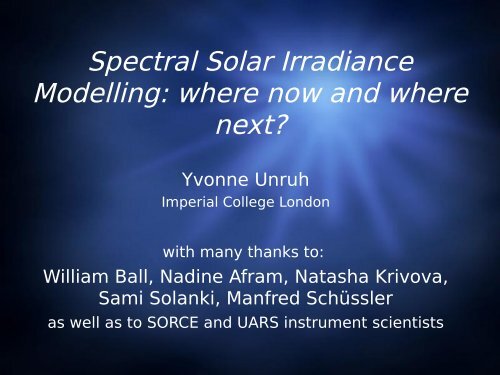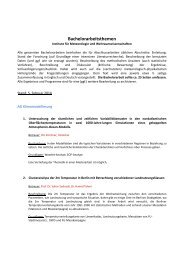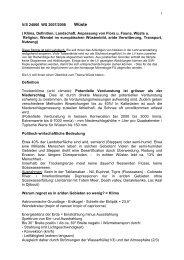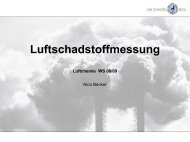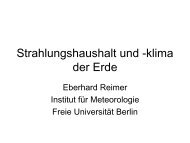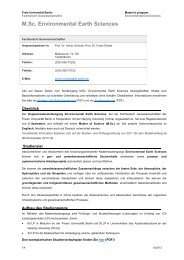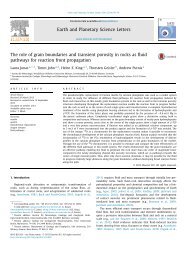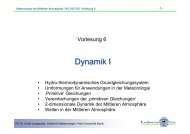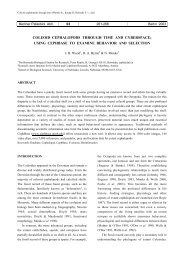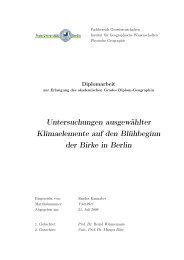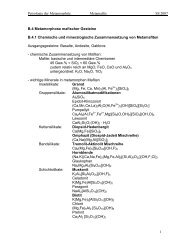Yvonne Unruh
Yvonne Unruh
Yvonne Unruh
Create successful ePaper yourself
Turn your PDF publications into a flip-book with our unique Google optimized e-Paper software.
Spectral Solar Irradiance<br />
Modelling: where now and where<br />
next?<br />
<strong>Yvonne</strong> <strong>Unruh</strong><br />
Imperial College London<br />
with many thanks to:<br />
William Ball, Nadine Afram, Natasha Krivova,<br />
Sami Solanki, Manfred Schüssler<br />
as well as to SORCE and UARS instrument scientists
Overview<br />
• Spectral solar irradiance: what do we<br />
know?<br />
• Tests of SSI models<br />
– Long-term inconsistencies?<br />
– Short term uncertainties<br />
• SSI from magneto-convection<br />
simulations<br />
• Conclusions
State of Affairs?<br />
Measurements models<br />
TSI rotational �����������������������<br />
cycle �����������������������<br />
����������cycle minima ? (�)<br />
Maunder min �����������������������?<br />
SSI rotational ���������������������(for most λ)<br />
cycle �and������������������(for some λ?)<br />
(wavelength dependent)<br />
cycle minima �����������������������?<br />
Maunder minima �����������������������?
What are the problems?<br />
Measurements:<br />
- Lack of continuous measurements<br />
- Insufficient overlap between different instruments<br />
- Calibration once instruments are in space /<br />
degradation corrections<br />
Models:<br />
- What produces the irradiance variations? (Can we<br />
just extrapolate from rotational → cyclic → secular<br />
variability?)<br />
- What are best / sufficient tracers?<br />
- Uncertainties in contrasts:<br />
– spectral synthesis<br />
– model atmospheres
Tests of Contrast Calculations<br />
SATIRE:<br />
- continuum images → spot coverage<br />
- magnetograms → facular filling coverage<br />
Time<br />
dependent<br />
- emergent contrasts<br />
– Currently not feature dependent,<br />
though scaled according to magnetic<br />
field of features<br />
– (cf Shapiro et al; Fontenla et al;<br />
Ermolli et al for different<br />
approaches)
Tests of Contrast Calculations
Tests of Contrast Calculations
SATIRE – SIM: comparisons<br />
200 - 300 nm
SATIRE – SIM: comparisons<br />
200 - 300 nm<br />
facular brightening too large<br />
(mainly during active phases)
SATIRE – SIM: comparisons<br />
970 - 1600 nm
SATIRE – SIM: comparisons<br />
lack of filling-factor<br />
sensitivity?<br />
970 - 1600 nm
+ SATIRE<br />
� SORCE/SIM<br />
SATIRE – SIM: in detail<br />
During May 2004 –<br />
reasonably active time
+ SATIRE<br />
� SORCE/SIM<br />
SATIRE – SIM: in detail<br />
During May 2004 –<br />
reasonably active time
Early<br />
2008 –<br />
much<br />
more<br />
quiet<br />
time<br />
SATIRE – SIM: in detail<br />
SIM<br />
SATIRE
spots and faculae: cycle vars<br />
spots<br />
total<br />
faculae
spots and faculae: cycle vars<br />
total<br />
spots<br />
faculae
MURaM<br />
Magnetoconvection simulations:<br />
288 x 288 x 100 points<br />
corresponding to<br />
6 x 6 x 1.4 Mm<br />
mean vertical magnetic flux:<br />
0, 50, 200 & 400 G<br />
vertical velocity<br />
Temperature vertical mag flux<br />
see Vögler et al 2005, A&A 429,<br />
5000 K<br />
10000 K<br />
↓ 9<br />
km/s<br />
↑ 9<br />
km/s<br />
2 kG<br />
-1 kG
From MURaM to disk-centre intensities 1:<br />
T B<br />
Tot<br />
al<br />
Mg G<br />
band II<br />
UV<br />
(268nm)<br />
Missing:<br />
B for<br />
200G<br />
run<br />
5 μ
From MURaM to disk-<br />
centre intensities 2:<br />
G-band images for different<br />
mean mag fluxes<br />
50<br />
G<br />
200<br />
G<br />
0<br />
G<br />
400<br />
G
mag<br />
pore<br />
mag<br />
bright<br />
point<br />
Individual features<br />
lane<br />
granule
Individual features
50 G<br />
200 G<br />
400 G<br />
MURAM<br />
disk-centre<br />
contrasts:<br />
50 G<br />
200 G<br />
400 G
S<br />
A<br />
T<br />
I<br />
R<br />
E<br />
Average limb-behaviour
S<br />
A<br />
T<br />
I<br />
R<br />
E<br />
+<br />
M<br />
U<br />
R<br />
A<br />
M<br />
Average limb-behaviour
Conclusions<br />
• Excellent agreement between models and<br />
observations on rotational timescale<br />
- some (small) uncertainties in UV and NIR<br />
• Are starting to understand cycle variations; SIM<br />
long-term trends seem unlikely starting with<br />
magnetically induced changes<br />
• Magneto-convection simulations allow the<br />
calculation of ab-initio contrasts<br />
– dependence of spectral shape on magnetic flux<br />
– Initial results are encouraging, but also some<br />
surprises... not straightforward!
SATIRE background<br />
<strong>Unruh</strong> et al 1999, A&A 345, 635<br />
Fligge et al 2000, A&A 353, 380<br />
Reconstructions (cyclical and shorter<br />
timescales)<br />
Krivova et al 2003, A&A 399, L1<br />
Wenzler et al 2006, A&A 460, 583<br />
<strong>Unruh</strong> et al 2008, A&A 486, 311<br />
Long-term reconstructions<br />
Krivova et al 2007, A&A 467, 335 (and refs<br />
therein)<br />
MURaM background


